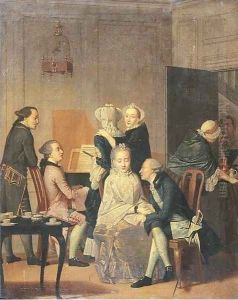Elisabeth Geertruid Wassenbergh Paintings
Elisabeth Geertruid Wassenbergh was a Dutch painter born in 1729 in Groningen, Netherlands, into an artistic family. Her father, Jan Abel Wassenbergh, was also a painter, and it was under his guidance that Elisabeth began her journey in the arts. During a time when female artists were not commonly recognized or encouraged, Elisabeth managed to carve out a name for herself, primarily focusing on genre painting, portraits, and still lifes. Her work is characterized by meticulous attention to detail, vibrant colors, and the ability to capture the essence of her subjects with a delicate finesse.
Elisabeth's skills were honed within the confines of her family's workshop, a common practice for women artists at the time. Despite the limitations placed on women in the art world, she achieved a level of recognition unusual for female painters of her era. She remained in Groningen for most of her life, where she contributed significantly to the local art scene. Her paintings often depicted scenes of everyday life, imbued with a sense of warmth and realism that attracted patrons and admirers.
Throughout her career, Elisabeth Geertruid Wassenbergh faced the challenge of working in a male-dominated field, yet her work was well received, and she enjoyed a successful career. After her death in 1781, her contributions to Dutch art were somewhat overshadowed by her male contemporaries, a fate common to many women artists of her time. However, in recent years, there has been a resurgence of interest in her work, with art historians and collectors recognizing her contributions to the Dutch Golden Age of painting. Elisabeth Geertruid Wassenbergh's legacy lives on, not only in her beautiful paintings but also as a pioneer for female artists in a restrictive era.
